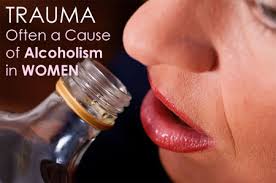Articles On Drug Addiction and Recovery
Women At Greater Risk Of Harm By Alcoholism

Description: Women coping with alcoholism report greater problems with both physical and social functioning, more bodily pain, and poorer physical and mental health than men.
The University of Michigan
News Service
412 Maynard
Ann Arbor, MI 48109-1399
Contact: Colleen Newvine
Phone: (734) 764-7260
E-mail: cnewvine@umich.edu
Web: https://www.umich.edu/~newsinfo
Women at greater risk of harm by alcoholism, says study by U-M researcher.
ANN ARBOR—Women suffering from alcoholism show greater effects on their daily lives than do alcoholic men, according to a study University of Michigan Prof. Kyle L. Grazier plans to present later this month.
Women coping with alcoholism report greater problems with both physical and social functioning, more bodily pain, and poorer physical and mental health than men, according to data Grazier and co-author Kathleen Bucholz at Washington University analyzed in a three-year, $2 million study funded by the National Institute of Alcohol Abuse and Alcoholism. Grazier teaches in the U-M School of Public Health’s Department of Health Management and Policy.
Grazier and Bucholz tracked more than 700 people initially interviewed as part of a larger National Institutes of Health study conducted in five American cities 20 years ago.
In their study, Grazier and Bucholz located three groups of respondents from the St. Louis sample: those diagnosed as stably alcoholic, borderline alcoholic and those unaffected by alcohol in the original study. They conducted three interviews and reviewed all medical records for care received over a two-year period. Grazier noted that their approach is unique because most research examines alcoholics in treatment centers where they’re easiest to find, but they looked at individuals in the community, including a broad spectrum of alcoholics who have and have not received treatment.
“We don’t know very much about people in the general community,” Grazier said. There have been no other community-based longitudinal studies that have followed individuals for almost 20 years to examine the long-term health services effects of alcohol use and abuse.
Women considered stable alcoholics showed greater effects on their daily life, including simple activities like walking and shopping, than men in that group.
Grazier and Bucholz are exploring reasons for the disparity, whether biological or social.
Those causes carry implications for the way physicians treat female patients and ways community-based programs educate people about the long-term health risks of alcohol.
Grazier plans to present the study at the First World Congress on Women and Mental Health in Berlin, Germany, March 27-31 (https://www.akm.ch/wmh2001/). This is the first meeting of its kind in which investigators from around the world will focus on the relationship between psychiatry, psychosomatics, neurosciences, obstetrics and gynecology.
In addition, Grazier will present a second study at the Congress—a $300,000, three-year National Institute for Mental Health-funded study on the effects of managed mental health care on women. She looked in particular at what are known as “carve out” programs, in which a separate administrative structure manages mental health and substance abuse service apart from other medical care.
Grazier gained access to records for 45,000 employees at a large West Coast company, one of the first to implement a carve out program, and looked for changes in costs and health care use over the six years since the inception of the program.
In looking at the records, which were stripped of employees’ personal identifiers, Grazier saw that carve outs had more effect on women than men—for example, they made fewer visits to care givers, and when they did receive care, they more frequently used alternative providers such as social workers, which are less expensive to insurers.
She noted that carve out programs appear to increase access and utilization among both men and women in need of entry-level services. “However, the managed care arrangement significantly reduced access to higher-intensity service use to a greater extent for women than for men. Women with mental health needs were almost twice as likely as men to have health services curtailed beyond the minimal level,” Grazier wrote in her study overview.
Grazier said she can’t draw conclusions about the quality of care received by women, but said the study does raise the question.
She is now looking at the impact of insurance coverage level on women’s treatment, as she believes women in dual-income households where both spouses are insured get different care than those who are single. In those dual-insurance situations, often the coverage from one plan can pick up what’s not paid for by the other, making care more affordable.
